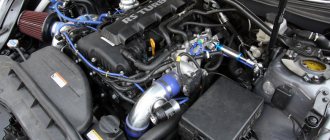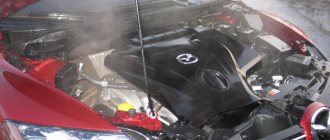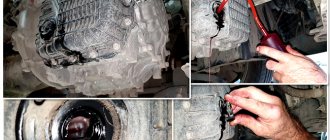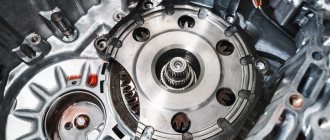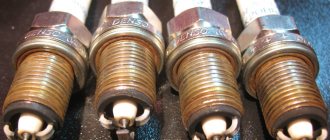The automatic transmission is a fairly reliable unit, but during operation the possibility of various malfunctions should not be ruled out. As a rule, the main sign of problems are shocks, jerks and kicks of the automatic transmission, which can occur both when switching gearbox modes on the spot and while moving.
Let us note that quite often the driver notices the appearance of automatic transmission jolts when the car is stationary, when when turning on “D” the car jerks, jolts appear when turning on the “R” mode (reverse), etc. In this article, we will look at why the car jerks in an automatic transmission when you engage reverse gear, and also what jerks indicate when shifting into “D” (drive).
When might kicking occur?
Automatic transmission inside view
In normal condition, a car with an automatic transmission should operate without jerking or vibration. If the listed manifestations are noted, the car should be sent for diagnostics. As a rule, this problem is most often encountered by car owners with an automatic transmission installed.
It should be noted that automatic transmission vibration can occur at different speed modes. In particular:
- when engaging reverse gear;
- idling;
- during acceleration;
- when changing speed modes.
Box vibration manifests itself as a beating, which is transmitted to the box selector. What are the reasons for this?
Causes of malfunctions of the valve body with torque converter
Automatic transmission failures are associated with the exhaustion of the transmission elements. If the automatic transmission vibrates in mode D, while the car is on the brake, you should definitely check the valve body with the torque converter.
The valve body is an integral part of the automatic transmission, which passes transmission fuel through the channels. The torque converter loses its functions due to natural wear and tear of its components. If the clutch fails, characteristic vibrations will appear. You also need to pay attention to the integrity of the bearings. When they are deformed, a characteristic noise will appear when the speed increases. Also, the car may stop moving backwards or forwards. To replace worn parts, the torque converter must be disassembled.
The service life of the valve body is affected by the operating conditions of the vehicle and how often its diagnostics were carried out. Overheating of this device may occur as a result of towing in mud or snow.
The valve body includes the valve plate and the ECU. To overhaul them, you need to acquire a special repair kit. The automatic transmission control unit affects the functioning of the torque converter.
If clogged valves are found during valve body diagnostics, they need to be cleaned. A common source of problems with the valve body is the use of low-quality oil.
Thus, vibrations can occur during acceleration, when switching gears, as a result of improper operation of the automatic transmission, which causes wear of its individual elements. To minimize the risk of premature failure of the oil receiver, you need to change the coolant in a timely manner. The main reason why vibration occurs in position D is a breakdown of the valve body. If the torque converter or valve body malfunctions, not only vibration will be noted, but also overheating of the gearbox and incorrect operation of the box.
Source
Causes of automatic transmission vibrations
A common reason why vibration began to be observed is that the gearbox input shaft has broken. As a rule, because of this, the box begins to vibrate during acceleration.
Vibrations may occur when the engine is cold when starting. Typically, this is the result of the car not being warmed up enough before starting the trip. In rare cases, vibrations occur due to loose fasteners.
You also need to pay attention to the quality of the gear oil used. The appropriate fluid should be used for each individual model. If there is a shortage of it, oil starvation of the main gearbox mechanisms will occur. Due to the presence of wear products in the oil, the valve body valves become contaminated.
Vibrations can also occur after repair work has been carried out (incorrect installation). Also, untimely maintenance of the automatic transmission leads to breakdowns in the transmission system. The car is subject to diagnostics. It is necessary to check the valve body with torque converter, filter, and gearbox mount. However, in some cases, vibration may be associated with breakdown of the chassis mechanisms or wheel imbalance.
Article on the topic: DIY Renault Logan automatic transmission repair
Reasons related to the box
Vibration can cause some automatic transmission problems:
- Deformation of the input shaft of the box.
Sample of input shaft:
A change in the geometry of the shaft, which has occurred for some reason, can provoke vibration and beating felt by the driver. The box will vibrate during acceleration, regardless of the currently active gear.
- Insufficient oil level.
A lack of transmission fluid causes oil starvation of the elements; automatic transmissions are especially sensitive to the amount of oil. If it is not enough, the transmission components wear out at an accelerated pace; over time, the automatic transmission begins to vibrate, “push”, grind, until it eventually fails.
The wrong type of fluid poured into the box, oil wear and contamination with foreign particles can also cause the box to “kick” and vibrate. In addition, similar symptoms sometimes appear when driving in cold weather on an unheated gearbox, when the oil is viscous and does not provide proper performance characteristics.
- Worn out box cushions.
Signs of a clogged filter
A car with an automatic transmission is equipped with a filter, the function of which is to clean the transmission fluid from metal shavings from worn parts. Over time, this consumable becomes clogged, resulting in worse oil flow. Because of this, the lubrication system begins to become dirty. The solution in this situation is to install a new filter. It is recommended to carry out this procedure together with changing the transmission oil. As a rule, the need to change the oil in an automatic transmission occurs after 60,000 km.
The following signs indicate that the filter element is clogged:
- the car is slipping;
- shocks when changing gears;
- Gear changes occur with a delay.
The filter on an automatic transmission is replaced after removing the pan, which must be cleaned of settled contaminants.
A malfunction of the automatic transmission can be recognized by shocks when changing speed modes and a high level of vibration. This is a reason to contact a professional auto mechanic.
Thus, a timely replaced filter allows you to increase the durability of the working elements of the transmission.
Vibration when accelerating
Vibration during acceleration may occur due to an unadapted automatic transmission. After repair or fluid replacement, each machine must undergo computer adjustment of gear ratios. Or the driver himself can do this. Methods for adapting an automatic transmission to the driving style of a particular driver were described in an article dedicated to adaptation.
If the vibration does not go away and appears when changing gears, the torque converter may be faulty. Computer diagnostics cannot check the “donut”. Therefore, you will have to completely disassemble the box and remove the torque converter. After disassembling and replacing the gas turbine engine, be sure to remember to balance the torque converter.
Write in the comments how you dealt with machine vibration?
Automatic transmission malfunction
If you have diagnosed the box and found a fault in the automatic transmission, then it needs repair. A malfunction in the torque converter during acceleration will give poor dynamics, and old oil will affect the appearance of jerks and jerks when switching.
Read
How to properly warm up a car with an automatic transmission
If the gears are thrown down rarely, the acceleration dynamics are positive, the car does not push, but vibration is present, the problem may lie outside the automatic transmission. You will need to check the engine - the heart of the car.
Engine malfunction
A clogged engine fuel filter is a common cause of vibration in a car. Another reason could be bad fuel. Low-quality gasoline quickly clogs the injectors. The engine starts to slow down.
In the case of low-quality gasoline, the vibration will disappear during acceleration. But, if the ignition coils fail, the engine will begin to sneeze during acceleration. You will feel a drop in engine speed. The vibration from the engine will be transmitted to the entire car body.
If the lambda probe fails, the vibration will also spread throughout the body, as with a clogged throttle valve. It will be necessary to clean the damper and replace the lambda probe.
CV joints in the front axles
CV joints in the front axles are subject to premature wear. Especially if the car is not intended for driving on dirt roads, and the driver actively uses it under difficult operating conditions.
The constant velocity joints of the drives are worn out and it is difficult to notice with the eye. It is determined by the vibration that spreads throughout the body during acceleration.
The driver can also determine the problem with the CV joints by driving the car in one direction or the other on a straight road.
Write in the comments if you have experienced problems with worn CV joints? How was the fault determined?
Wheel bearing
A wheel bearing malfunction is determined by a crunching sound when driving and vibration through the body and into the steering wheel. When accelerating, the driver will feel as if something is slowing down his car.
Read
Do-it-yourself diagnostics and repair of Mazda automatic transmission
At the first appearance of such symptoms, I advise you to immediately go to a service station. You can create an emergency situation on the roads, since the car, if you do not pay attention to the problem, will increasingly and more often be pulled towards the wheel on which the wheel bearing has failed.
Warped disc or damaged tire
Improper balancing of the front wheels, especially, can create vibration. If the disc is deformed or the tire is damaged, the driver will feel not only vibration, but also deterioration in vehicle control.
It is better to immediately dismantle crooked rims and torn tires and replace them with new ones. Then you will create safe travel conditions for yourself and other road users.
Signs of deformation of the automatic transmission cushion
Vibration may appear when the automatic transmission is engaged in reverse gear as a result of wear on the cushion that belongs to this box. This component fixes the gearbox to the car body. If the pillow has lost its shock-absorbing properties, there will be a loss of speed and impacts when the engine is turned off. A worn-out part needs to be replaced. Rubber-metal options are in demand. They smooth out vibrations that occur during movement well and are resistant to temperature changes.
Frequent trips over rough terrain contribute to the premature loss of the properties of the pillow.
Article on the topic: Choosing an oil change for a Lada Priora gearbox
The need for balancing
Neither tires nor wheels are perfect in terms of geometry and composition. So, due to different masses in different parts of the wheel, those places where the weight is greater will pull the wheel axle towards themselves. At high speeds, the force will be transmitted to the rods, then to the steering wheel.
It is very important to perform balancing from time to time. Especially after changing tires or wheels. Using this procedure, you can equalize the masses of the wheels at each point. Driving a vehicle with unbalanced wheels can cause rapid wear on the chassis and suspension, a problem that is more difficult to correct.
Wheel alignment
If the wheel is installed at the wrong angle, this is also one of the reasons for unpleasant beating. Adjusting these angles is an important process once body vibrations are detected. What can be done to fix it? Adjust wheel alignment on a special stand. It is also recommended to replace the tires if it is visible that they are not wearing properly.
Vibration and shocks of the automatic transmission.
What is the reason for the strong vibration when stopping at a traffic light in position D of the automatic transmission selector?
Why do jerks and jerks occur when shifting gears? Most often, vibration is associated with the inclusion of program “neutral” (PN). This can be checked by switching the selector to manual shift mode: vibration should decrease. Otherwise, the motor or its mounts are faulty.
The PN function forces the torque converter to rotate passively: the engine-gearbox pair is disconnected. This was done for the sake of the environment. In engines with an automatic transmission, the flywheel is much less massive than in cars with a manual transmission. Therefore, its role as a vibration damper is played by the torque converter. The software "neutral" essentially turns it off - and the vibrations increase. On naturally aspirated 1.6 engines this problem was very common, and was overcome by a software change. Similar cases with 1.4 turbo engines are rare, so the manufacturer is still looking for solutions.
Jerks and jerks when changing gears have a lot of reasons. For example, at very low or high ambient temperatures, this behavior of the automatic transmission indicates a temperature adaptation mode. The control program is trying to protect the box. Gear changes occur at increased oil pressure, at higher engine speeds, or as quickly as possible to avoid clutch slipping. Together this causes the sensation of impacts.
Another reason is the adaptation of switching when the driver changes his driving style (an active driver replaced a calm one; after uniform movement along the highway, the car entered a stormy metropolis). However, the jerking should stop after a couple of presses on the gas pedal.
Of course, jerking can also be caused by malfunctions - from low oil level to worn clutches. Our automatic machines have wear adaptation, but it will smooth out shocks only up to a certain threshold.
A comment. Opel is one of the few manufacturers that recommend periodic oil changes in automatic transmissions. During normal operation under normal conditions, the Germans advise changing the fluid in the GF6 box (on most cars with a gasoline engine) at a mileage of 80,000–100,000 km, and in difficult conditions - twice as often. Intervals for the AF40 unit (on diesel engines) are 120,000–140,000 km and 70,000–75,000 km, respectively. It is imperative to change the oil even after slight overheating of the unit - it quickly degrades! Some of these recommendations are specified in the maintenance regulations.
Methods to combat automatic transmission shocks and vibrations:
1. Updating engine and automatic transmission firmware using the MDI device. 2. Adaptation of automatic transmission using the MDI device. 3. Raising the idle speed using the MDI device, up to a maximum of 800 rpm. It helps with vibration when stopping at a traffic light in position D. 4. Changing the oil in the automatic transmission. Here everyone decides for themselves when and how to change the oil. 5. Installing a chip from Zlodd. I myself am the owner of this chip, and I noticed that the machine stopped kicking a lot. All the shocks did not go away completely, but it became more comfortable to drive, especially in the city. 6. Before putting a large load on the automatic transmission, it is imperative to warm it up to at least 30 degrees, otherwise a replacement box awaits you)) How to find out the temperature of the automatic transmission? Open additional BC OPCOM tabs as described here.
CV joints in the front axles
Although this is not such a popular reason, it is a rather vulnerable spot, which is why vibration when accelerating is a common occurrence. Experienced car enthusiasts recommend starting diagnostics with this mechanism. The procedure must necessarily include a tactile test. If there are scratches, replace the equal angle hinges. It is better to replace this part in pairs.
Engine mounts, gearbox mounts and other reasons
This is another possible group of reasons why a car may shake when accelerating. All these problems can arise for various reasons. For example, as a result of examinations, a breakdown of one of the power unit airbags is discovered. It's easy to find out - increase the engine speed when vibrations appear.
Body vibration when accelerating from 80 km/h to 100 km/h can also occur if there is a problem with the gearbox. Testing this hypothesis is very simple. It is recommended to reach a speed of about 85 km/h, then depress the clutch pedal and watch how the car behaves. Engage third gear and release the clutch. Accelerate from 50 km in the last gear of the transmission.
If the nature of the beats does not change during all these events, the gearbox is not to blame. If the vibration level increases when the box is connected to work, then you can check its involvement.
This method is suitable for both manual transmissions and automatic transmissions. In the case of an automatic transmission, at speeds of approximately 90 km/h, turn on 3.2, D, N on the gearbox, and then monitor the operation of the automatic transmission and the car. Watch the vibrations. Most often, the fault of the box in beating is minimal, but practice shows that there is such a possibility.
Unreliable wheel mounts
This problem is also easy to fix and diagnose. This is a simple but very dangerous reason. The fastenings can be loosened even on one wheel, and this is enough to cause shaking. If the problem is not resolved in time, emergency situations may occur. If the wheel falls off while driving, the repair will be quite expensive - you will have to replace the disc and hub, and the brake disc.
The symptoms in this case are very similar to vibrations due to tires or bent wheels. But there is a cyclical pattern here, although not at all speeds.
